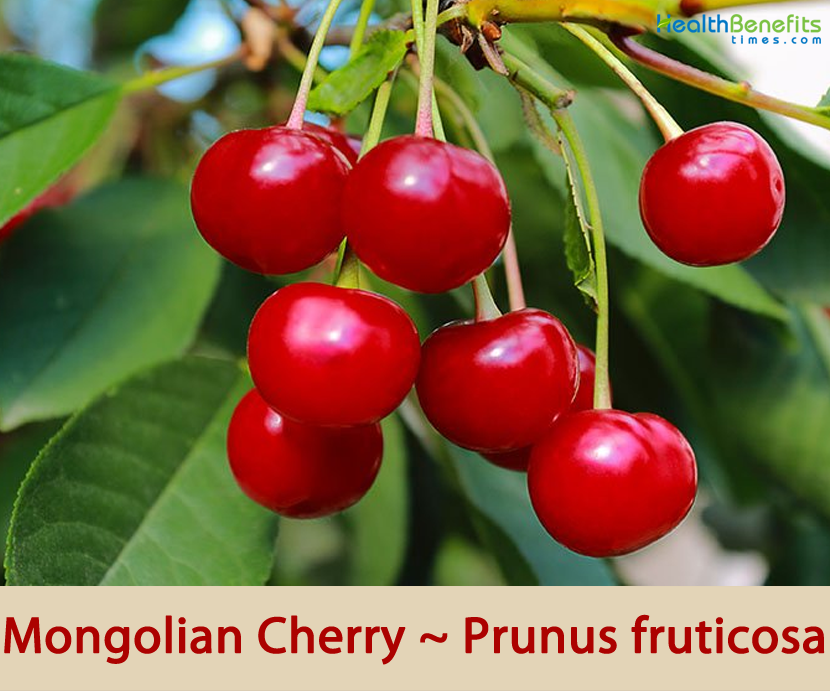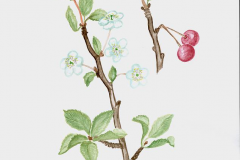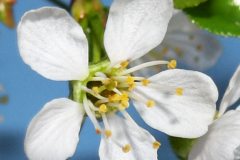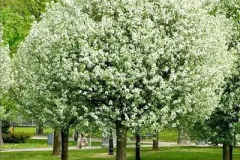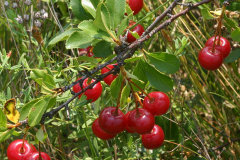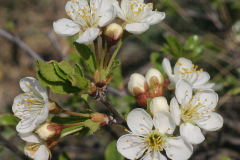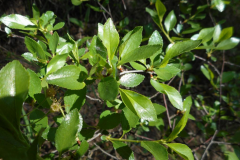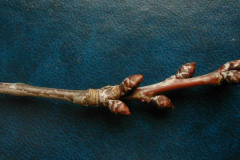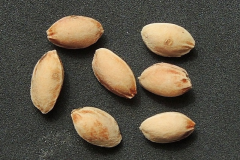| Mongolian Cherry Quick Facts | |
|---|---|
| Name: | Mongolian Cherry |
| Scientific Name: | Prunus fruticosa |
| Origin | Ciscaucasia, western Siberia, Kazakhstan, Xinjiang China, western Russia, Ukraine, Poland, Czech Republic, Germany, Belarus, Moldova, Bulgaria, Romania, Hungary, Serbia, Austria, and Italy |
| Colors | Green when young turning to very deep reddish purple as they mature |
| Shapes | About the size of a large pea, globose to pyriform, about 8–25 mm in diameter |
| Taste | Sour-sweet, or tart |
| Health benefits | Helps to stimulate respiration, improves digestion, coughs, colds, gout and gives a sense of well-being. |
| Name | Mongolian Cherry |
|---|---|
| Scientific Name | Prunus fruticosa |
| Native | Ciscaucasia, western Siberia, Kazakhstan, Xinjiang China, western Russia, Ukraine, Poland, Czech Republic, Germany, Belarus, Moldova, Bulgaria, Romania, Hungary, Serbia, Austria, and Italy |
| Common Names | Dwarf cherry, Ground cherry, European ground cherry , European dwarf cherry, Steppe cherry, Siberian cherry, Mongolian cherry |
| Name in Other Languages | Arabic: Karaz qizm ‘uwrubiyun (كرز قزم أوروبي) Azerbaijani: Yabanı gilas Bulgarian: Stepna višna (степна вишна), khrastovidna cheresha (храстовидна череша) Chinese: Cao yuan ying tao (草原樱桃) Croatian: Patuljasta trešnja Czech: Třešeň křovitá Danish: Dvaergkirsebaer , Joedekirsebaer Dutch: Dwergkers English: Dwarf cherry, Ground cherry, European ground cherry , European dwarf cherry, Steppe cherry, Siberian cherry, Mongolian cherry Finnish: Euroopankääpiökirsikka, Arokirsikka French: Cerisier buissonnant, Cerisier des steppes, Cerisier nain, Griottier nain, Prunier nain, Prunier buissonant German: Steppenkirsche, Zwergkirsche, Zwergekirsche, Strauch-Kirsche, Steppenkirschbaum, Zwergkirschbaum Hungarian: Csepleszmeggy, molyhos madárhúr Italian: Ciliegio nano, Ciliegio cespuglioso, pruno fruticosa Kazakh: Dalalıq şïye, Далалық шие, دالالىق شىييە Persian: پرونوس فروتیکوسا Polish: Wishnia karlowata, Wisnia karlowata, wisienka stepowa Portuguese: Cereja-anã Russian: Stepnaia vishnia, Vishennik, Vishnia kustarnikovaia (Вишня кустарниковая) Serbian: Divlja višnja (дивља вишња), stepska višnja (степска вишња) Slovak: Cerešňa krovitá Spanish: Cerezo enano, cerezo enano europeo, cerezo mongol Swedish: Stäppkörsbär Turkish: Bodur kiraz Ukrainian: Vyshnya shtepova (Вишня степова), vyshnya kushchova (вишня кущова) Upper Sorbian: Mała wišnja |
| Plant Growth Habit | Much-branched, deciduous, xerophytic, winter-hardy, cherry-bearing shrub |
| Growing Climates | Shrubby thickets, dry grassland, forest-steppes, steppe zone, broad-leaved forest margins, open dry slopes, flatlands with dry steppe vegetation, karst areas |
| Soil | Thrives in a well-drained moisture-retentive loamy soil, growing well on limestone. It also prefers some lime in the soil but is likely to become chlorotic if too much lime is present |
| Plant Size | Usually grows 20 – 100 cm tall, occasionally reaching 200 cm |
| Bark | Bark is dark brown with yellow lenticels |
| Leaf | Oblanceolate to obovate, tapering to both ends about 12 mm long and 6 mm wide, with acuminate apex, glabrous above, thick, serrated with crenate margin, dark glossy green, yellow in autumn, with a short petiole |
| Flowering season | Early May |
| Flower | Flowers are white hermaphroditic blossoms in leafy bracts located 2-4 each on short peduncles in sessile umbels. They are produced in usually stalk less umbels of about four from buds on the previous year’s shoots, each flower on a slender stalk 1⁄2 to 1 in. long. They are pollinated by bees. |
| Fruit Shape & Size | Fruits are about the size of a large pea, globose to pyriform, about 8–25 mm in diameter |
| Fruit Color | Green when young turning to very deep reddish purple as they mature |
| Propagation | By Seeds, Cuttings |
| Taste | Sour-sweet, or tart |
| Plant Parts Used | Fruits, Seeds |
| Season | July to August |
| Lifespan | Approximately 20 years |
| Precautions |
|
Plant Description
Mongolian Cherry is a much-branched, deciduous, xerophytic, winter-hardy, cherry-bearing shrub that normally grows about 20 – 100 cm tall, occasionally reaching 200 cm. It grows at a medium rate, and under ideal conditions can be expected to live for approximately 20 years. The plant is found growing in shrubby thickets, dry grassland, forest-steppes, steppe zone, broad-leaved forest margins, open dry slopes, flatlands with dry steppe vegetation and karst areas. It thrives in a well-drained moisture-retentive loamy soil, growing well on limestone. It also prefers some lime in the soil but is likely to become chlorotic if too much lime is present. It is highly tolerant of urban pollution and will even thrive in inner city environments. The plant produces suckers, forming a thicket. Roots are abundant. The plant requires full sun; it is a steppe rather than a forest plant, although it does form thickets at the edges of open forest.
Leaves
Leaves are oblanceolate to obovate, tapering to both ends about 12 mm long and 6 mm wide, with acuminate apex, glabrous above, thick, serrated with crenate margin, dark glossy green, and yellow in autumn, with a short petiole.
| Bud Arrangement | Alternate |
| Bud Color | Brown |
| Bud Size | 1/8 inch |
| Leaf Type and Shape | Simple, ovate-elliptical |
| Leaf Margins | Crenate-serrulate |
| Leaf Surface | Glossy, smooth |
| Leaf Length | 3/4 to 2 inches |
| Leaf Width | 3/8 to 1 inch |
| Leaf Color | Dark glossy-green; yellow fall color |
Flowers
The flowers are white hermaphroditic blossoms in leafy bracts located 2-4 each on short peduncles in sessile umbels. They are produced in usually stalk less umbels of about four from buds on the previous year’s shoots, each flower on a slender stalk 1⁄2 to 1 in. long. They are pollinated by bees. In the Northern Hemisphere, the plant flowers in May. This is a self-pollinating variety, so it doesn’t require a second plant close to set fruit. The flowers are its basis of bee-keeping honey plant.
| Flower Type | 2 or 4 flowers in sessile umbels, with leafy bracts |
| Flower Color | White |
Fruits
Fertile flowers are followed by fruits that are about the size of a large pea, globose to pyriform, about 8–25 mm in diameter. Fruits are initially green turning to very deep reddish purple as they mature. Fruit start ripening in August. The taste is sour-sweet, or tart.
| Fruit Type | Cherry-shaped fruit, globose |
| Fruit Color | Dark red |
Traditional uses and benefits of Mongolian Cherry
- In small amounts this extremely poisonous compound helps to stimulate respiration, improves digestion and gives a sense of well-being.
- It has been used as an astringent for coughs, colds, gout, and in cancer research.
Culinary Uses
- Fruit can be consumed raw or cooked.
- As a sour tasting cherry, the fruit is used in cooking, and for jams and jellies.
- It can also be made into preserves or dried for later use.
- Seed can be consumed raw or cooked.
- Do not eat the seed if it is too bitter.
Other Facts
- A green dye can be obtained from the leaves.
- A dark grey to green dye can be obtained from the fruit.
- It is planted in hedgerows as an ornamental plant privacy screen and windbreak.
- It is a host plant for bees and other beneficial insects and birds.
- It is used for screen, hedge, border and group plantings.
- The shrub’s network of penetrating roots is useful for soil stabilization in designed landscapes and habitat restoration projects.
- The plant is a good choice for attracting birds to your yard.
Mongolian Cherry is recommended for the following landscape applications;
- Mass Planting
- General Garden Use
- Naturalizing And Woodland Gardens
- Orchard/Edible Landscaping
References:
https://www.itis.gov/servlet/SingleRpt/SingleRpt?search_topic=TSN&search_value=24779#null
https://npgsweb.ars-grin.gov/gringlobal/taxon/taxonomydetail?id=29899
https://pfaf.org/user/Plant.aspx?LatinName=Prunus+fruticosa
http://www.theplantlist.org/tpl1.1/record/rjp-5896
https://en.wikipedia.org/wiki/Prunus_fruticosa
https://www.ag.ndsu.edu/trees/handbook/th-3-9.pdf
https://gd.eppo.int/taxon/PRNFR
https://www.cabi.org/isc/datasheet/44284
https://temperate.theferns.info/plant/Prunus+fruticosa
https://plants.usda.gov/home/plantProfile?symbol=PRFR2


